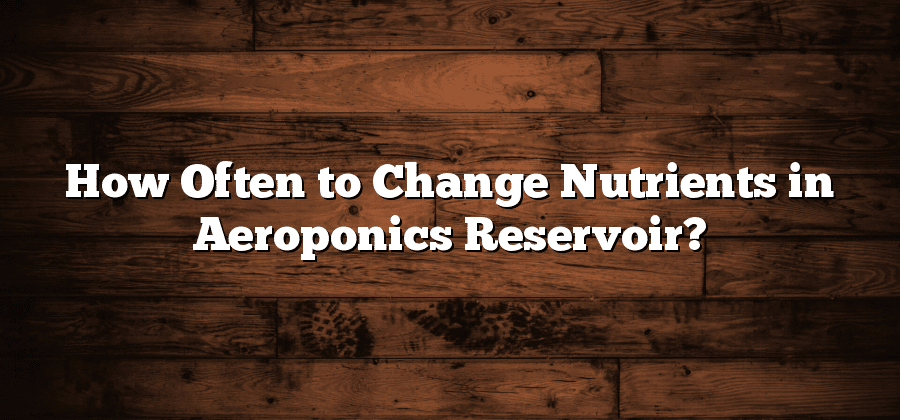Importance of Nutrient Change in Aeroponics
Aeroponics, as a soilless cultivation method, offers numerous benefits for indoor gardening. However, one crucial aspect of successful aeroponic systems is the regular change of nutrients. This is of utmost importance to ensure optimal plant health and growth. Nutrient change involves replacing the nutrient solution in the reservoir with a fresh, properly balanced solution. While it may seem like an extra task, it is an essential practice that cannot be overlooked.
The main reason for changing nutrients in aeroponics is to maintain the right balance of essential elements for plant uptake. Over time, the nutrient solution in the reservoir can become depleted and imbalanced due to plant absorption and evaporation. This can result in nutrient deficiencies and toxicities, negatively impacting plant growth and overall performance. By regularly changing the nutrient solution, growers can provide plants with a fresh supply of nutrients, promoting healthy development and maximizing yields. Additionally, nutrient change also helps to prevent the buildup of harmful pathogens and algae, ensuring a clean and disease-free environment for the plants.
Signs of Nutrient Depletion in Reservoir
Plants grown in an aeroponics system rely heavily on a well-balanced nutrient solution for their growth and development. However, just like any other form of cultivation, nutrient depletion can occur, leading to adverse effects on plant health. One of the most noticeable signs of nutrient depletion in the reservoir is a change in the color and appearance of the plant leaves. As the nutrient levels begin to drop, the leaves may start to turn yellow or show signs of chlorosis. This can be attributed to the imbalanced nutrient solution, which is unable to provide the necessary elements for the plants’ metabolic processes. Additionally, the growth rate of the plants may also slow down, and they may become more susceptible to diseases and pests.
Apart from visible changes in leaf color and growth rate, another sign of nutrient depletion in the reservoir is a decrease in the pH level. pH plays a crucial role in nutrient uptake by affecting the availability and solubility of essential elements. As the nutrients are depleted, the pH of the reservoir solution may shift, becoming either too acidic or too alkaline. This change in pH can hinder the plants’ ability to absorb the remaining nutrients, further exacerbating the nutrient deficiency. Monitoring the pH level regularly is therefore essential to ensure the optimal nutrient uptake and plant health in an aeroponics system.
Ensuring a well-maintained reservoir with balanced nutrient levels is key to preventing nutrient depletion and promoting healthy plant growth in aeroponics.
Factors Affecting Nutrient Lifespan in Aeroponics
Factors affecting nutrient lifespan in aeroponics can have a significant impact on the overall health and success of plants grown in this system. One crucial factor is the quality of the nutrients used. Using high-quality, well-balanced nutrient solutions ensures that plants receive all the essential elements they need for healthy growth. It is important to choose a nutrient formula specifically designed for aeroponic systems to ensure optimal nutrient uptake and avoid deficiencies.
Another factor that influences nutrient lifespan is the pH level of the nutrient solution. Aeroponic systems typically require a slightly acidic pH range of around 5.5 to 6.5 for optimal nutrient uptake. If the pH drifts too high or too low, it can affect nutrient availability to the plants, leading to nutrient imbalances or deficiencies. Regular monitoring and adjustment of pH levels are necessary to maintain a stable and healthy nutrient reservoir.
In addition to nutrient quality and pH levels, the growth stage and nutrient requirements of the plants also play a role in nutrient lifespan. Different plants have varying nutrient needs at different stages of growth, such as higher nitrogen requirements during vegetative growth and increased phosphorus and potassium needs during flowering or fruiting stages. Proper understanding of a plant’s nutrient requirements at each growth stage ensures that the nutrient solution is appropriately adjusted to meet those needs, optimizing nutrient lifespan and plant health.
Monitoring Nutrient Levels in Aeroponics Reservoir
Maintaining adequate nutrient levels in the aeroponics reservoir is crucial for the success of your aeroponic system. Regularly monitoring the nutrient levels allows you to ensure that your plants are receiving the proper nutrients they need to thrive.
One effective way to monitor nutrient levels is by using a nutrient meter or a TDS (total dissolved solids) meter. These devices measure the electrical conductivity of the nutrient solution, which can give you an indication of the nutrient concentration. By regularly testing the nutrient solution, you can identify any imbalances or deficiencies and make adjustments accordingly.
Another method of monitoring nutrient levels is by visually inspecting the reservoir. Look for any changes in color, sedimentation, or unusual odor. These can be signs of nutrient depletion or the presence of harmful substances. It is important to address any issues promptly to prevent nutrient deficiencies in your plants.
Overall, monitoring nutrient levels in the aeroponics reservoir is an essential task that should not be overlooked. By using appropriate tools and techniques, you can ensure that your plants are getting the right balance of nutrients for optimal growth and health.
Understanding Nutrient Uptake in Aeroponics
A crucial aspect of successful aeroponic systems is understanding the nutrient uptake process. Nutrients in aeroponics are typically delivered to plant roots as a fine mist, allowing for direct absorption. This method maximizes nutrient efficiency, enabling plants to absorb essential elements more effectively compared to traditional soil-based cultivation methods.
The process of nutrient uptake in aeroponics involves the plant’s roots coming into direct contact with the nutrient-laden mist. The fine particles of the mist adhere to the root surface, allowing the plant to absorb them. This direct absorption not only ensures that the roots receive the necessary nutrients but also minimizes waste and excess runoff that can occur in other cultivation systems. By comprehending this process, aeroponic growers can optimize nutrient delivery to meet the specific needs of their plants, fostering healthy growth and maximizing yields.






